User Tools
This is an old revision of the document!
Table of Contents
Words of wisdom: “Heat people, not places.”1)
Heating
Many RVers snowbird to get away from temperature extremes, but others enjoy the cold or sometimes get caught in it. The method one uses for staying warm will depend on whether or not one has “hookups” (grid connection).
TL;DR: heating an RV from batteries/solar is impractical.2) We generally use propane.
“Fear of propane will be expensive.” – Sternwake3)
space heating
Fuel-consuming heaters create air-quality issues, including decreased oxygen and increased carbon monoxide. This is why we ventilate.
Here’s an overview of the amount of toxic byproducts introduced into the RV by a properly functioning appliance:4)
- electric heaters – none
- vented heaters – none
- catalytic heaters – some
- open flame heaters – more
When shore power is available electric space heating may be preferable for air quality reasons.
propane heating
There are a couple of things to remember about heating with propane:
- burning propane generates water vapor which will increase the humidity in your vehicle. You may require additional ventilation or dehumidification.
- even clean-burning, low CO emission heaters generate much more CO in low oxygen levels. This is the reason you are supposed to ventilate.
- any forced air heater will require electrical power to run the fan.
flame
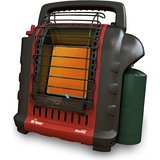 The most common way to heat off-grid is with open flame propane, and the most common non-OEM propane heater for RVers is the Mr.Heater Buddy series.
The most common way to heat off-grid is with open flame propane, and the most common non-OEM propane heater for RVers is the Mr.Heater Buddy series.
- Little Buddy - 3800btu.5) A small round unit that mounts directly to a 1# propane bottle. It's rather tall – compare the size of the 1# propane bottle it sits on.
- Big Buddy - 400btu, 9000btu, 18,000btu. Oversized for most camper applications.
Tip: you can turn the Buddy down below the LOW setting by depressing the gas knob like you are turning it off, then slowly easing the setting back to the desired level. The flames will “flutter” a bit if set too low – increase slightly from that point. Check your CO detector to make sure your CO output isn't increased.
Tip: you can run the Buddy on just the pilot light; this will emit a small but noticeable amount of heat (~300-500 BTU).9)
It is common to run a standard Buddy heater off the camper's large propane cylinder, perhaps teed off the stove line. Unless the line is regulated an inline "filter" (or more properly a “separator”10)) is required. This keeps oils leached out by high pressure from entering the heater and clogging the orifice.
catalytic
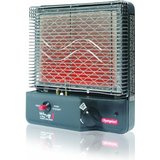 The other major propane heater is the Camco Olympian Wave heater catalytic design, particularly the 3 (3k BTU11)) and 6 (6k BTU12)). Catalytic heaters make more efficient use of propane which should reduce costs and humidity. Catalytic heaters require extra care so their catalyzing surfaces don't get contaminated by dust or other particles. Camco says users should cover the heater when not in use, and that the catalytic pad may have to be replaced if contaminated or after a set number of years.13)
The other major propane heater is the Camco Olympian Wave heater catalytic design, particularly the 3 (3k BTU11)) and 6 (6k BTU12)). Catalytic heaters make more efficient use of propane which should reduce costs and humidity. Catalytic heaters require extra care so their catalyzing surfaces don't get contaminated by dust or other particles. Camco says users should cover the heater when not in use, and that the catalytic pad may have to be replaced if contaminated or after a set number of years.13)
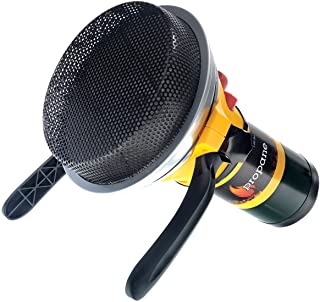 Now discontinued, Coleman made smallish propane catalytic heaters:14)
Now discontinued, Coleman made smallish propane catalytic heaters:14)
- the tilted BlackCat (3,000 btu), etc. Note: a clone of the sportcat has appeared.
- fan-forced ProCat (3,000 btu)
diesel heating
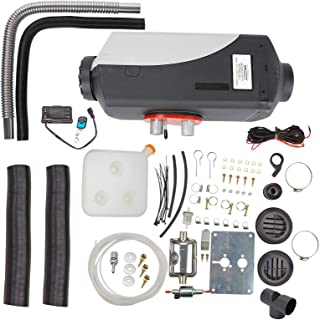 Recently chinese diesel heaters (a la Webasto) have come on the market. They use a bit of electricity for the thermostat and fan. Gas van will need a small diesel tank to run it.
Recently chinese diesel heaters (a la Webasto) have come on the market. They use a bit of electricity for the thermostat and fan. Gas van will need a small diesel tank to run it.
- superfastracing recommended by likesweirdthings17)
white gas heating
White gas, sold as Coleman camp fuel, was a common heating/cooking/lantern fuel until the relatively recent ascendance of propane.18) Propane is probably safer for generations who did not grow up camping with stoves, pocketknives, et.c Part of it is safety, and part is that the gear just isn't made anymore.
Coleman fuel gear has relatively little smell while running at temperature, but start-up and shut-down can create fumes and intense odors. Those activities should be done outdoors.
catalytic
 Catalytic heaters were common in the 60s-70s and can be found at garage sales, thrift shops, or ebay. Repair instructions.
Catalytic heaters were common in the 60s-70s and can be found at garage sales, thrift shops, or ebay. Repair instructions.
- block-shaped heater 513A (3,000-5,000 btu) (pic)
flame
Heat drums were made for some Coleman stoves.
candle
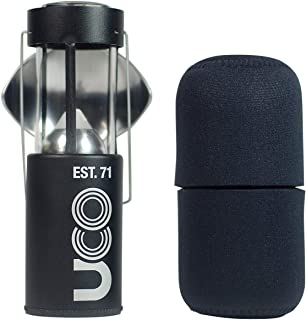 Candles are an oft-discussed source of heat. I typical candle will put out something like 240btu19) of heat. They also give off light and can be used as a lantern.
Candles are an oft-discussed source of heat. I typical candle will put out something like 240btu19) of heat. They also give off light and can be used as a lantern.
Downsides include soot, tippiness, and lead content in some wicks. Using candles in a “lantern” fixture may be safer.
The most common candle lantern is the UCO lantern, which uses a proprietary candle which UCO says produces 450 btu. They make tealight versions in non-collapsible mini and collapsible micro sizes.
on shore power
When on unmetered shore ("mains") power electric heating is a practical solution and will conserve propane. The efficiency of electric heaters is the same (3.41 W / W or 3412BTU in a 1000W heater)20) so your choice will be made on other features.
space heaters
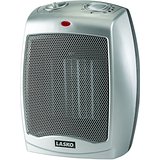 The most common type of space heater is the resistance wire heater with forced airflow.
The most common type of space heater is the resistance wire heater with forced airflow.
Note: high-amp draws like electric space heaters may trip your converter's breakers. Here is a tip for finding a 110v outlet in your RV that does not go through the converter:
“With shore power connected go to your main AC breaker box and find the breaker for your inverter, it is usually 30 amps, and open it. Now check all receptacles for power. If you find one that has power it does not go through the inverter.” - garym11421)
Another note: it has been reported that some RV parks do not allow space heaters.22)
resistance wire heaters
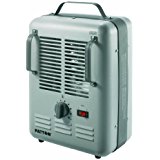 The simplest and cheapest space heaters are resistance wire heaters with a fan blowing over them. The wire is like that found in a toaster or hair dryer. The traditional design is a "milk house" utility heater that looks like it was first made in the 1940s.
The simplest and cheapest space heaters are resistance wire heaters with a fan blowing over them. The wire is like that found in a toaster or hair dryer. The traditional design is a "milk house" utility heater that looks like it was first made in the 1940s.
Ceramic heaters encase the resistance wire in a ceramic matrix. The increased surface area means the wire can be run at a lower temperature, reducing fire hazards. It also has more even heating than the bare wire models since the ceramic adds thermal inertia. This type of heater is the most popular space heater on Amazon, with over 10,000 reviews.
Micathermic heaters encase the heating element in a mica matrix, yielding similar results as the ceramic heater but often requiring more frontal area cases. Mica heaters can be made quite thin.23)
personal heaters
Inexpensive, low-wattage24) “personal” heaters have recently come to the market with prices as low as $10. Intended to be used at/under a work desk in an office, they deliver 675 - 850btu/hr. 'Dwellers with excess solar power or access to shore power could use these without affecting the bank.
radiant heaters
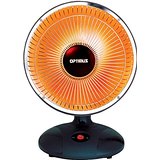 These heaters are intended to generate infrared heat directly onto the target. These are highly directional and could overheat some nearby materials.
These heaters are intended to generate infrared heat directly onto the target. These are highly directional and could overheat some nearby materials.
oil-filled heaters
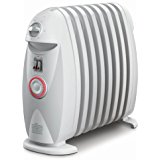 These heaters are similar to residential radiators; they provide steady and silent heat, gently heating the space through convection. These work best when the area is already warm and they can be left on for long stretches of time. Due to low temperature these may be the safest space heaters. You can also dry socks on them, which might end in tragedy with other kinds of heaters.
These heaters are similar to residential radiators; they provide steady and silent heat, gently heating the space through convection. These work best when the area is already warm and they can be left on for long stretches of time. Due to low temperature these may be the safest space heaters. You can also dry socks on them, which might end in tragedy with other kinds of heaters. ![]()
contact heating
Applying heat directly is much more efficient than heating the surrounding space25) and may be powered by solar or battery power. Examples of contact/direct heat include:
- heating pads
- heat packs
- electric mattress pads.
You can also DIY heated gear with carbon heat strips.

